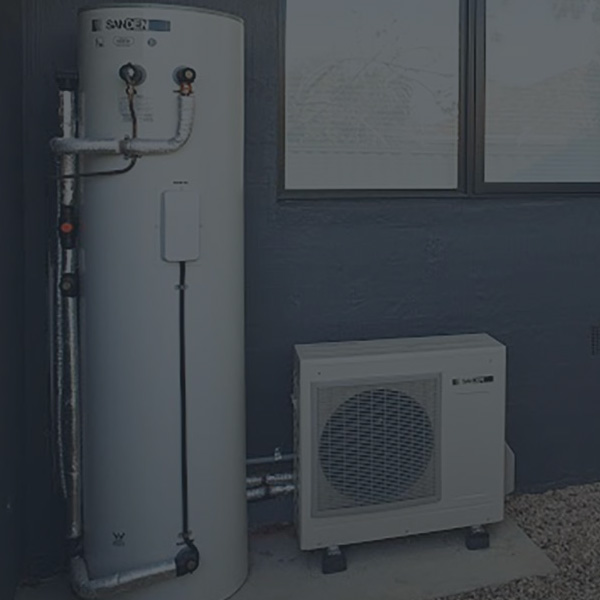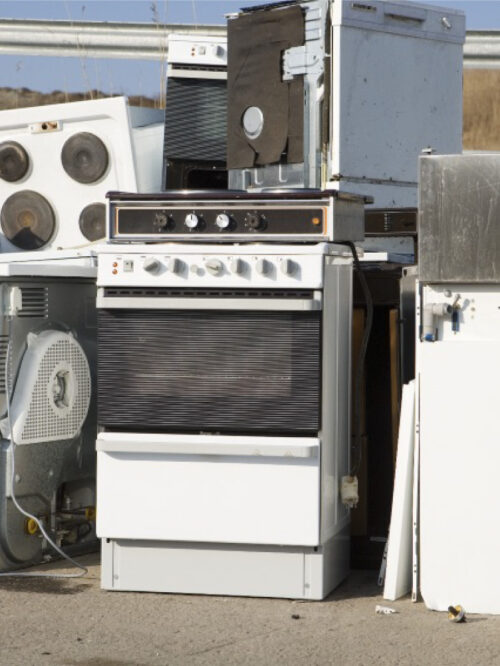CHAPTER 4: HOW TO GET OFF GAS
Hot water
Water heating can be one of the largest energy users in a home. It can account for around 21% of total energy use adding considerably to energy bills each year. Large energy reductions are possible if you replace a conventional water heater with a heat pump, solar thermal or solar electric system.
Determining the required size of a water heater is an important aspect of system selection. Sizing is a trade-off between cost and performance. A key element of performance is the level of risk of running out of hot water. The system should be sized for the dwelling, not necessarily its occupants. It is generally accepted to size at around 50 litres of hot water per person per day (although this may be decreasing as homes adopt water-efficient showerheads, and newer dishwashers and washing machines heat their own water).
In a storage system it is good to have 1.5 days capacity.
The Energy Ratings hot water systems page includes a useful fact sheet on hot water heating.
Your Energy Savings, Your Home and the Energy Council also have dedicated solar hot water pages.
Heat pump
A heat pump moves, or ‘pumps’, heat from one medium into another. Air-source heat pump hot water systems concentrate heat from the air and dump it into a water storage tank. In this way, heat pumps use renewable energy— heat from the air—although they do still use some electricity to run. Heat pumps also need a refrigerant fluid to concentrate heat from the air.
The global warming potential (GWP) of the refrigerant should be considered if the refrigerant leaks or is dumped illegally at the heat pump’s end of life. The best refrigerant is CO2, which not only has the lowest GWP but also makes for the most efficient heat pumps. However, the higher running pressures of CO2 heat pumps does make them the more expensive option to buy initially.
Using a heat pump water heater provides significant efficiency gains. Heat pump hot water systems are much more efficient than conventional resistive electric water heaters which use an element, much like your kettle. Compared to resistive water heaters, they can reduce year-round energy requirements for hot water by at least 50%, and by as much as 80% depending on the climate, brand and model. On the existing electricity grid, the cost of water heating is roughly halved when using a heat pump compared to a natural gas water heater. With financed solar panels and a home battery providing the energy, the costs fall even lower to around a third of gas heating costs.


Earthworker Energy Manufacturing Cooperative aims to grow dignified and democratic employment in the region, whilst producing important energy-saving renewable energy technology like heat pumps. Photo by Gregory Lorenzutti for Renew Magazine.
Air-source heat pump systems range in price from around $2500 through to more than $5000 (before rebates and small-scale technology certificates).
Heat pump hot water systems are configured as either one-piece (integrated) units or split systems. In an integrated system, the heat pump is mounted on top of or beside the tank. In a split system, the heat pump is in a separate unit like the outdoor unit for an air conditioner, connected to the tank with pipes. Depending on the design, the pipes between the tank and the heat pump unit will carry either refrigerant or water. An integrated unit has the benefit of simple installation and small size, whereas a split system allows greater flexibility in locating the two components. For example, you could locate the tank indoors and the heat pump outside.
Entry-level heat pumps have a coefficient of performance (COP) of around three, although some can go as high as five. For a heat pump with a COP of three, for every unit of electricity used it moves three times this much energy into the water, making it three times more efficient than a resistive electric unit. Heat pump systems include a thermostat to run whenever the tank temperature falls below a pre-set level (e.g. 60 °C), but you may want to use your heat pump’s in-built timer so that it will only operate at certain times—for example, to take advantage of off-peak tariffs, or warmer temperatures and solar-generated electricity during the day.
Some heat pumps struggle in air temperatures approaching freezing and may use a resistive electric element to provide extra power in these conditions. If you live in an area that sees regular near-freezing temperatures, look for a system that will operate under such conditions without the need for a resistive element. Systems that use CO2 as a refrigerant handle cold ambient temperature well.
Renew answers your questions for hot water system installers.
Solar Thermal
Usually called solar hot water, a solar thermal hot water system consists of a hot water storage tank connected via pipework to solar collector panels on the roof. The collector panels are placed on a (preferably) north-facing roof, although a west-facing roof can also work well in many cases. The tank can be situated immediately above the panels on the roof (called a close-coupled system), above and a small distance away from the panels within the roof cavity, or at ground level (known as a split or remote- coupled system).
For split systems, a pump and controller are required to circulate water through the panels. As the sun shines on a collector panel, water in its internal pipes heats up. This heated water is circulated up the collector and out through a pipe to the storage tank. Cooler water from the bottom of the tank is then returned to the bottom of the collector, replacing the warmer water.
Some systems don’t heat the water directly but instead heat a fluid similar to antifreeze used in vehicle cooling systems. This fluid flows in a closed loop and transfers the collected heat to the water in the tank via a heat exchanger. Other systems use copper tubes called heat pipes to transfer the heat to the tank.
Solar thermal hot water systems vary widely in price depending on the number of collectors, the tank size, tank material (mild steel or stainless steel), the type of system (close coupled or split), the selected options and, of course, the brand. Smaller close- coupled systems can be found for under $2000 while larger split systems can cost up to $6000 or more, before an STC rebate is applied.
There are two common types of solar thermal collector panels: flat-plate and evacuated tube. Flat plate collectors are basically a large flat box containing an array of pipes, all with a glass lid. Evacuated tube collectors consist of several long glass tubes which usually have a second glass tube inside. The space between the tubes is evacuated of most of the air to form a vacuum, and the tubes work much like a vacuum flask, keeping in the collected heat so that it transfers efficiently to the water.
Which type you use depends on personal preference and your climate. Evacuated tubes tend to work better in the cooler months in colder climates, but in warmer climates, either collector will perform well. If selecting an evacuated tube collector, check to see how easily tubes can be replaced if broken, for example from exceptionally large hail stones.
Boosting of solar thermal systems will be required for times of insufficient sunshine. PV diversion and direct PV systems both use solar-generated electricity to power an electric tank, generally a conventional resistive element tank. Electric PV diversion systems use excess solar generation—when solar generation exceeds electricity usage in the home—to heat water in an electric storage water heater. When your solar system starts exporting excess generation to the grid, a controller turns the diverter on and feeds that energy into the water heater instead.


Direct PV
An alternative approach to water heating using solar-generated electricity is electric direct PV. In such systems, solar PV panels are connected directly to a traditional electric resistive water heater via a maximum power point tracking controller/inverter, which ensures you get the most energy possible from the PV panels. The PV panels may be connected to the bottom element in a two-element tank or the single element in a standard single-element tank.
While some direct PV systems are sold as a controller and you supply your own solar array, others are sold as a complete package of solar array and inverter to simplify installation and ensure the system complies to safety standards.
At present, very few solar installers/ electricians will have wired electric direct PV systems, so you will need to use the installer recommended by the system supplier. Installers must account for specific safety requirements in Australian standards. When using direct PV systems with a mains pressure tank it is important that the controller is also an inverter so that the element is fed AC power, as standard water tank thermostats are designed to switch AC and using them with DC directly can cause them to fail. Without a functioning thermostat, the tank’s pressure relief valve becomes your only defence against an exploding tank. Direct PV systems that produce DC output must not be connected to a mains pressure tank, only to open-vented tanks, and not via any installed thermostat.
Direct PV systems can cost as little as $300 for a simple DIY controller, through to several thousand dollars for a complete package.
For days with inadequate input from the solar PV, boosting will be required for both PV diversion and direct PV systems. Boosting can use the electric element in the tank for overnight heating from mains grid power (via the settings on the diverter or a separate boosting timer) or on-demand boosting from an instantaneous water heater.
It is important to consider how much boosting you are willing to pay for over winter. Water heating requires more energy input in the cooler months due to higher hot water demands. Winter is also when solar input is lowest.
Also consider appropriate boosting times, especially if you use most of your hot water
at night. Everyone’s hot water usage patterns are different, as is the output from PV systems, depending on time of year, local climate and personal preferences, so you may need to work out a boosting regime that works best for you. Just make sure the boosting element is on a timer with an override switch so that you can experiment to find the right balance without needing an electrician.
Electric instantaneous
You might want to consider an instantaneous electric water heater, one that heats the water as it passes through the heater, if your roof has minimal solar access for solar thermal hot water and a heat pump can’t be fitted. An instantaneous unit can use a lot of power to heat a useful volume of water by several tens of degrees so may be unsuitable for many homes.
Instantaneous electric water heaters range in size from in-tap or point-of-use units of 2 kW or so, used to supply just one hot water tap and which really only allow for low water flows (probably not a shower) if you want a good level of water temperature increase, through to large three-phase wall-mounted units that can supply a whole house.
Smaller point-of-use units (up to 2.3 kW) can use a regular electrical power circuit. Power draw on the larger units can be more than 20 kW continuously so the home needs a suitable electrical connection to the grid such as three-phase power (not that common in domestic situations) or a high current single-phase connection. Either way, new electrical wiring will most likely need to be installed to the new heater.
As they operate at high power for the short time they’re needed (such as a five-minute shower), they generally aren’t a good option if you want to use excess solar electricity—your solar may not be sufficient to cover the high power draw, so you’ll end up importing from the grid while they’re being used and then return to exporting after.
Instantaneous electric water heater performance depends on the incoming water temperature. They are rated to heat water by a set number of degrees for a given water flow rate, so the colder the incoming water, the lower the outlet temperature. If you live in a cold climate where water temperatures are low, you must consider the inlet water temperature. Of course, this also applies to storage type water heaters, but they heat water over a long period of time rather than having to heat it on demand.
Instantaneous electric water heaters range in price from around $300 to over $1000.
The installation of any system should be carried out by an appropriately qualified and experienced plumber and electrician to make sure it is properly sized and installed.











